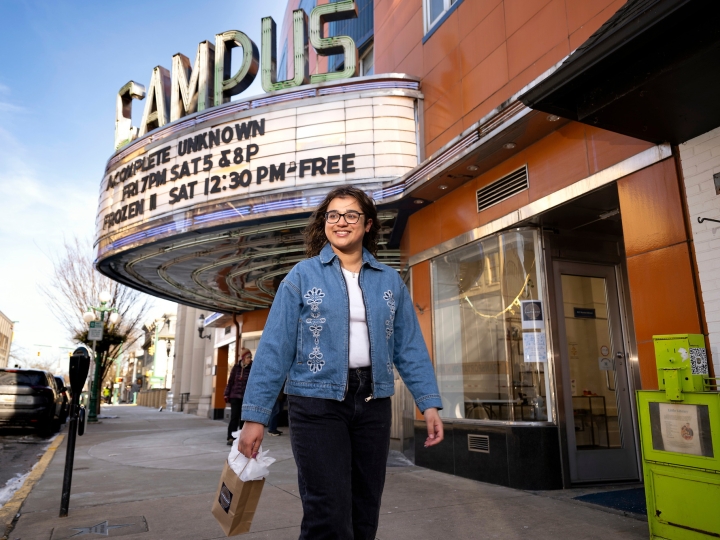NSF Grant to Fast-track Research Computing at Bucknell
August 1, 2017
Bucknell's research computing network is getting a turbocharge.
Thanks to a grant of nearly $400,000 from the National Science Foundation (NSF), Bucknell student and faculty researchers will soon have access to an exclusive, high-speed internet pipeline that will accelerate upload and download times as much as tenfold. A new addition to the Bucknell network referred to as the Bucknell Science DMZ (a networking term that borrows the political abbreviation for demilitarized zone) will provide data-intensive research projects segregated and unrestricted access to the University network, meaning researcher's data-transfer speeds will not get bogged down by competing traffic, even if the rest of campus is watching Netflix.
Param Bedi, vice president for Library & Information Technology and principal investigator of the NSF grant, likens the network to an open lane of the autobahn running alongside a crowded Pennsylvania Turnpike.
"It's restricting traffic for high-speed applications," Bedi said. "You're not competing with Netflix, Google searches, Facebook — anything else."
The projected gains in speed the project will enable are truly staggering. A file transfer of 1 terabyte over Bucknell's network now takes between 2 hours 40 minutes and 3 hours 20 minutes, depending on traffic volume. Over the DMZ it will take less than 20 minutes. Transfers of less than 15 gigabytes will be nearly instantaneous. In addition to the speed improvements on campus, the project will address the needs of researchers in sharing large files across the internet with colleagues around the world.
Bucknell will be partnering with Cisco, the world's largest networking company, in designing and implementing the DMZ. Bucknell faculty writing in support of the grant said the increased speed will take their research (which frequently includes undergraduate student collaborators) to a new and exciting level.
"The number of open and accessible questions in the field of health informatics is astounding," said Professor Nathan Ryan, mathematics, who is currently working in partnership with Geisinger Health System researchers on a health-care analytics project. "Even though I have only recently begun work in this area, my collaborators and I have had some early successes. The Science DMZ [... will] only serve to accelerate our research even more."
Because of the enormous volume of information his research involves, Ryan and his Geisinger colleagues have resorted to exchanging data in person, swapping secure USB drives and non-networked computers, which has inhibited the project's progress. Having a quick and secure solution for transferring and analyzing these large data sets will simplify and accelerate his research, he said.
Ryan is among an increasing number of Bucknell faculty, including numerous professors in the departments of biology and computer science, who have begun incorporating big-data analysis in their research. It's a trend that will only continue to grow, Bedi said, making the DMZ project essential to Bucknell's emergence as a preeminent institution for undergraduate and faculty research.
"It's pretty unique for a school of our size to have a science DMZ," Bedi said. "A lot of times we think of ourselves as a small liberal arts school, but we want to provide our faculty with the resources and infrastructure of a research institution — to not limit ourselves by our size, but to provide the tools for our faculty in engineering, the sciences and even the humanities and social sciences to take the next step in their research."
While the project's name suggests that science faculty and students will most directly and immediately benefit, its impact will not be limited to the sciences. Matt Gardzina, Bucknell's director of digital pedagogy and scholarship, noted that the network improvements will "extend far beyond [the sciences] and have a direct impact on a large percentage of faculty and students. For example, roughly 20 percent of our faculty, from disciplines across campus, are engaged in using GIS in their research and teaching."
While the number of faculty employing geographic-information-system (GIS) technology has made Bucknell a recognized leader in the field, Gardzina noted that network limitations have prevented students from fully utilizing GIS during class. Employing the Science DMZ will enable students to use this technology to its full potential in the classroom, enhancing student learning and building Bucknell's reputation as a leading institution for GIS studies.
The Science DMZ project follows and is enabled by a series of recent upgrades to Bucknell's network, which include the University's connection to the PennREN high-speed fiber-optic network as a charter member of the Keystone Initiative for Network Based Education and Research (KINBER) and its membership in the Internet2 community, which facilitates its connection to the nation's largest and fastest coast-to-coast research and education network. This next step in the evolution of high-speed networking at Bucknell is expected to come online in two years' time.

